Alta Gardens Nursing Home Garden Grove
Practice of growing and cultivating plants

Gardening is the practice of growing and cultivating plants as part of horticulture. In gardens, ornamental plants are often grown for their flowers, foliage, or overall appearance; useful plants, such as root vegetables, leaf vegetables, fruits, and herbs, are grown for consumption, for use as dyes, or for medicinal or cosmetic use.
Gardening ranges in scale from fruit orchards, to long boulevard plantings with one or more different types of shrubs, trees, and herbaceous plants, to residential back gardens including lawns and foundation plantings, and to container gardens grown inside or outside. Gardening may be very specialized, with only one type of plant grown, or involve a variety of plants in mixed plantings. It involves an active participation in the growing of plants, and tends to be labor-intensive, which differentiates it from farming or forestry.[1]
History [edit]
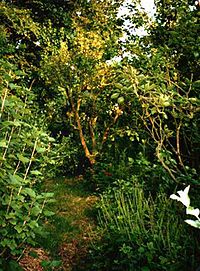
Ancient times [edit]
Forest gardening, a forest-based food production system, is the world's oldest form of gardening.[2] Forest gardens originated in prehistoric times along jungle-clad river banks and in the wet foothills of monsoon regions. In the gradual process of families improving their immediate environment, useful tree and vine species were identified, protected and improved while undesirable species were eliminated. Eventually foreign species were also selected and incorporated into the gardens.[3]
After the emergence of the first civilizations, wealthy individuals began to create gardens for aesthetic purposes. Ancient Egyptian tomb paintings from the New Kingdom (around 1500 BC) provide some of the earliest physical evidence of ornamental horticulture and landscape design; they depict lotus ponds surrounded by symmetrical rows of acacias and palms. A notable example of ancient ornamental gardens were the Hanging Gardens of Babylon—one of the Seven Wonders of the Ancient World —while ancient Rome had dozens of gardens.
Wealthy ancient Egyptians used gardens for providing shade. Egyptians associated trees and gardens with gods, believing that their deities were pleased by gardens. Gardens in ancient Egypt were often surrounded by walls with trees planted in rows. Among the most popular species planted were date palms, sycamores, fig trees, nut trees, and willows. These gardens were a sign of higher socioeconomic status. In addition, wealthy ancient Egyptians grew vineyards, as wine was a sign of the higher social classes. Roses, poppies, daisies and irises could all also be found in the gardens of the Egyptians.
Assyria was also renowned for its beautiful gardens. These tended to be wide and large, some of them used for hunting game—rather like a game reserve today—and others as leisure gardens. Cypresses and palms were some of the most frequently planted types of trees.
Gardens were also available in Kush. In Musawwarat es-Sufra, the Great Enclosure dated to the 3rd century BC included splendid gardens.[4]
Ancient Roman gardens were laid out with hedges and vines and contained a wide variety of flowers—acanthus, cornflowers, crocus, cyclamen, hyacinth, iris, ivy, lavender, lilies, myrtle, narcissus, poppy, rosemary and violets[5]—as well as statues and sculptures. Flower beds were popular in the courtyards of rich Romans.
The Middle Ages [edit]

The Middle Ages represent a period of decline in gardens for aesthetic purposes. After the fall of Rome, gardening was done for the purpose of growing medicinal herbs and/or decorating church altars. Monasteries carried on a tradition of garden design and intense horticultural techniques during the medieval period in Europe. Generally, monastic garden types consisted of kitchen gardens, infirmary gardens, cemetery orchards, cloister garths and vineyards. Individual monasteries might also have had a "green court", a plot of grass and trees where horses could graze, as well as a cellarer's garden or private gardens for obedientiaries, monks who held specific posts within the monastery.
Islamic gardens were built after the model of Persian gardens and they were usually enclosed by walls and divided in four by watercourses. Commonly, the centre of the garden would have a reflecting pool or pavilion. Specific to the Islamic gardens are the mosaics and glazed tiles used to decorate the rills and fountains that were built in these gardens.
By the late 13th century, rich Europeans began to grow gardens for leisure and for medicinal herbs and vegetables.[5] They surrounded the gardens by walls to protect them from animals and to provide seclusion. During the next two centuries, Europeans started planting lawns and raising flowerbeds and trellises of roses. Fruit trees were common in these gardens and also in some, there were turf seats. At the same time, the gardens in the monasteries were a place to grow flowers and medicinal herbs but they were also a space where the monks could enjoy nature and relax.
The gardens in the 16th and 17th century were symmetric, proportioned and balanced with a more classical appearance. Most of these gardens were built around a central axis and they were divided into different parts by hedges. Commonly, gardens had flowerbeds laid out in squares and separated by gravel paths.
Gardens in Renaissance were adorned with sculptures, topiary and fountains. In the 17th century, knot gardens became popular along with the hedge mazes. By this time, Europeans started planting new flowers such as tulips, marigolds and sunflowers.
Cottage gardens [edit]

Cottage gardens, which emerged in Elizabethan times, appear to have originated as a local source for herbs and fruits.[6] One theory is that they arose out of the Black Death of the 1340s, when the death of so many laborers made land available for small cottages with personal gardens.[7] According to the late 19th-century legend of origin,[8] these gardens were originally created by the workers that lived in the cottages of the villages, to provide them with food and herbs, with flowers planted among them for decoration. Farm workers were provided with cottages that had architectural quality set in a small garden—about 1 acre (0.40 ha)—where they could grow food and keep pigs and chickens.[9]
Authentic gardens of the yeoman cottager would have included a beehive and livestock, and frequently a pig and sty, along with a well. The peasant cottager of medieval times was more interested in meat than flowers, with herbs grown for medicinal use rather than for their beauty. By Elizabethan times there was more prosperity, and thus more room to grow flowers. Even the early cottage garden flowers typically had their practical use—violets were spread on the floor (for their pleasant scent and keeping out vermin); calendulas and primroses were both attractive and used in cooking. Others, such as sweet William and hollyhocks, were grown entirely for their beauty.[10]
18th century [edit]

In the 18th century gardens were laid out more naturally, without any walls. This style of smooth undulating grass, which would run straight to the house, clumps, belts and scattering of trees and his serpentine lakes formed by invisibly damming small rivers, were a new style within the English landscape, a "gardenless" form of landscape gardening, which swept away almost all the remnants of previous formally patterned styles. The English landscape garden usually included a lake, lawns set against groves of trees, and often contained shrubberies, grottoes, pavilions, bridges and follies such as mock temples, Gothic ruins, bridges, and other picturesque architecture, designed to recreate an idyllic pastoral landscape. This new style emerged in England in the early 18th century, and spread across Europe, replacing the more formal, symmetrical garden à la française of the 17th century as the principal gardening style of Europe.[11] The English garden presented an idealized view of nature. They were often inspired by paintings of landscapes by Claude Lorraine and Nicolas Poussin, and some were Influenced by the classic Chinese gardens of the East,[12] which had recently been described by European travelers.[12] The work of Lancelot 'Capability' Brown was particularly influential. Also, in 1804 the Horticultural Society was formed.
Gardens of the 19th century contained plants such as the monkey puzzle or Chile pine. This is also the time when the so-called "gardenesque" style of gardens evolved. These gardens displayed a wide variety of flowers in a rather small space. Rock gardens increased in popularity in the 19th century.
Types [edit]

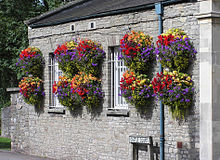

An organic garden on a school campus
Residential gardening takes place near the home, in a space referred to as the garden. Although a garden typically is located on the land near a residence, it may also be located on a roof, in an atrium, on a balcony, in a windowbox, on a patio or vivarium.
Gardening also takes place in non-residential green areas, such as parks, public or semi-public gardens (botanical gardens or zoological gardens), amusement parks, along transportation corridors, and around tourist attractions and garden hotels. In these situations, a staff of gardeners or groundskeepers maintains the gardens.
- Indoor gardening is concerned with the growing of houseplants within a residence or building, in a conservatory, or in a greenhouse. Indoor gardens are sometimes incorporated as part of air conditioning or heating systems. Indoor gardening extends the growing season in the fall and spring and can be used for winter gardening.
- Native plant gardening is concerned with the use of native plants with or without the intent of creating wildlife habitat. The goal is to create a garden in harmony with, and adapted to a given area. This type of gardening typically reduces water usage, maintenance, and fertilization costs, while increasing native faunal interest.
- Water gardening is concerned with growing plants adapted to pools and ponds. Bog gardens are also considered a type of water garden. These all require special conditions and considerations. A simple water garden may consist solely of a tub containing the water and plant(s). In aquascaping, a garden is created within an aquarium tank.
- Container gardening is concerned with growing plants in any type of container either indoors or outdoors. Common containers are pots, hanging baskets, and planters. Container gardening is usually used in atriums and on balconies, patios, and roof tops.
- Hügelkultur is concerned with growing plants on piles of rotting wood, as a form of raised bed gardening and composting in situ.[13] An English loanword from German, it means "mound garden." Toby Hemenway, noted permaculture author and teacher, considers wood buried in trenches to also be a form of hugelkultur referred to as a dead wood swale.[14] Hugelkultur is practiced by Sepp Holzer as a method of forest gardening and agroforestry, and by Geoff Lawton as a method of dryland farming and desert greening.[15] When used as a method of disposing of large volumes of waste wood and woody debris, hugelkultur accomplishes carbon sequestration.[13] It is also a form of xeriscaping.
- Community gardening is a social activity in which an area of land is gardened by a group of people, providing access to fresh produce, herbs, flowers and plants as well as access to satisfying labor, neighborhood improvement, sense of community and connection to the environment.[16] [17] Community gardens are typically owned in trust by local governments or nonprofits.[18]
- Garden sharing partners landowners with gardeners in need of land. These shared gardens, typically front or back yards, are usually used to produce food that is divided between the two parties.
- Organic gardening uses natural, sustainable methods, fertilizers and pesticides to grow non-genetically modified crops.
- Biodynamic gardening or biodynamic agriculture is similar to organic gardening, but it includes various esoteric concepts drawn from the ideas of Rudolf Steiner, such as astrological sowing and planting calendar and particular field and compost preparations.
- Commercial gardening is a more intensive type of gardening that involves the production of vegetables, nontropical fruits, and flowers from local farmers. Commercial gardening began because farmers would sell locally to stop food from spoiling faster because of the transportation of goods from a far distance. Mediterranean agriculture is also a common practice that commercial gardeners use. Mediterranean agriculture is the practice of cultivating animals such as sheep to help weed and provide manure for vine crops, grains, or citrus. Gardeners can easily train these animals to not eat the actual plant.[19]
[edit]
People can express their political or social views in gardens, intentionally or not. The lawn vs. garden issue is played out in urban planning as the debate over the "land ethic" that is to determine urban land use and whether hyper hygienist bylaws (e.g. weed control) should apply, or whether land should generally be allowed to exist in its natural wild state. In a famous Canadian Charter of Rights case, "Sandra Bell vs. City of Toronto", 1997, the right to cultivate all native species, even most varieties deemed noxious or allergenic, was upheld as part of the right of free expression.
Community gardening comprises a wide variety of approaches to sharing land and gardens.
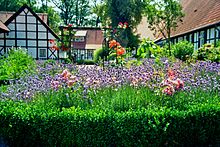
People often surround their house and garden with a hedge. Common hedge plants are privet, hawthorn, beech, yew, leyland cypress, hemlock, arborvitae, barberry, box, holly, oleander, forsythia and lavender. The idea of open gardens without hedges may be distasteful to those who enjoy privacy. The Slow Food movement has sought in some countries to add an edible school yard and garden classrooms to schools, e.g. in Fergus, Ontario, where these were added to a public school to augment the kitchen classroom. Garden sharing, where urban landowners allow gardeners to grow on their property in exchange for a share of the harvest, is associated with the desire to control the quality of one's food, and reconnect with soil and community.[20]
In US and British usage, the production of ornamental plantings around buildings is called landscaping, landscape maintenance or grounds keeping, while international usage uses the term gardening for these same activities.
Also gaining popularity is the concept of "Green Gardening" which involves growing plants using organic fertilizers and pesticides so that the gardening process – or the flowers and fruits produced thereby – doesn't adversely affect the environment or people's health in any manner.
Benefits [edit]
Gardening is considered by many people to be a relaxing activity. There are also many studies about the positive effects on mental and physical health in relation to gardening.[21] Specifically, gardening is thought to increase self-esteem and reduce stress.[22] As writer and former teacher Sarah Biddle notes, one's garden may become a "tiny oasis to relax and recharge [one's] batteries."[23]
Comparison with farming [edit]
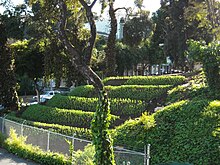
Berms of fava beans have been planted at Hayes Valley Farm, a community-built farm on the former Central freeway ramps of San Francisco
Gardening for beauty is likely[ original research? ] nearly as old as farming for food, however for most of history for the majority of people there was no real distinction since the need for food and other useful products trumped other concerns. Small-scale, subsistence agriculture (called hoe-farming) is largely indistinguishable from gardening. A patch of potatoes grown by a Peruvian peasant or an Irish smallholder for personal use could be described as either a garden or a farm. Gardening for average people evolved as a separate discipline, more concerned with aesthetics, recreation and leisure,[24] under the influence of the pleasure gardens of the wealthy.[ citation needed ] Meanwhile, farming has evolved (in developed countries) in the direction of commercialization, economics of scale, and monocropping.
In respect to its food-producing purpose, gardening is distinguished from farming chiefly by scale and intent. Farming occurs on a larger scale, and with the production of salable goods as a major motivation. Gardening happens on a smaller scale, primarily for pleasure and to produce goods for the gardener's own family or community. There is some overlap between the terms, particularly in that some moderate-sized vegetable growing concerns, often called market gardening, can fit in either category.
The key distinction between gardening and farming is essentially one of scale; gardening can be a hobby or an income supplement, but farming is generally understood[ by whom? ] as a full-time or commercial activity, usually involving more land and quite different practices. One distinction is that gardening is labor-intensive and employs very little infrastructural capital, sometimes no more than a few tools, e.g. a spade, hoe, basket and watering can. By contrast, larger-scale farming often involves irrigation systems, chemical fertilizers and harvesters or at least ladders, e.g. to reach up into fruit trees. However, this distinction is becoming blurred with the increasing use of power tools in even small gardens.
Monty Don has speculated on an atavistic connection between present-day gardeners and pre-modern peasantry.[25]
The term precision agriculture is sometimes used[ by whom? ] to describe gardening using intermediate technology (more than tools, less than harvesters), especially of organic varieties. Gardening is effectively scaled up to feed entire villages of over 100 people from specialized plots. A variant is the community garden which offers plots to urban dwellers; see further in allotment (gardening).
Garden ornaments and accessories [edit]
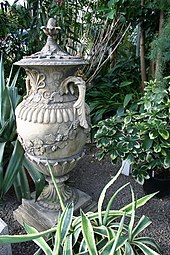
There is a wide range of garden ornaments and accessories available in the market for both the professional gardener and the amateur to exercise their creativity. These are used to add decoration or functionality, and may be made from a wide range of materials such as copper, stone, wood, bamboo, stainless steel, clay, stained glass, concrete, or iron. Examples include trellis, garden furniture, statues, outdoor fireplaces, fountains, rain chains, urns, bird baths and feeders, wind chimes, and garden lighting such as candle lanterns and oil lamps. The use of these items can be part of the expression of a gardener's gardening personality.
Gardens as art [edit]
Garden design is considered to be an art in most cultures, distinguished from gardening, which generally means garden maintenance. Garden design can include different themes such as perennial, butterfly, wildlife, Japanese, water, tropical, or shade gardens.
In Japan, Samurai and Zen monks were often required to build decorative gardens or practice related skills like flower arrangement known as ikebana. In 18th-century Europe, country estates were refashioned by landscape gardeners into formal gardens or landscaped park lands, such as at Versailles, France, or Stowe, England. Today, landscape architects and garden designers continue to produce artistically creative designs for private garden spaces. In the US, professional landscape designers are certified by the Association of Professional Landscape Designers.[26]
Garden pests [edit]
Garden pests are generally plants, fungi, or animals (frequently insects) that engage in activity that the gardener considers undesirable. A pest may crowd out desirable plants, disturb soil, stunt the growth of young seedlings, steal or damage fruit, or otherwise kill plants, hamper their growth, damage their appearance, or reduce the quality of the edible or ornamental portions of the plant. Aphids, spider mites, slugs, snails, ants, birds, and even cats are commonly considered to be garden pests.

Because gardeners may have different goals, organisms considered "garden pests" vary from gardener to gardener. Tropaeolum speciosum, for example, may be considered a desirable and ornamental garden plant, or it may be considered a pest if it seeds and starts to grow where it is not wanted. As another example, in lawns, moss can become dominant and be impossible to eradicate. In some lawns, lichens, especially very damp lawn lichens such as Peltigera lactucfolia and P. membranacea, can become difficult to control and are considered pests.
Garden pest control [edit]
There are many ways by which unwanted pests are removed from a garden. The techniques vary depending on the pest, the gardener's goals, and the gardener's philosophy. For example, snails may be dealt with through the use of a chemical pesticide, an organic pesticide, hand-picking, barriers, or simply growing snail-resistant plants.
Pest control is often done through the use of pesticides, which may be either organic or artificially synthesized. Pesticides may affect the ecology of a garden due to their effects on the populations of both target and non-target species. For example, unintended exposure to some neonicotinoid pesticides has been proposed as a factor in the recent decline in honey bee populations.[27] A mole vibrator can deter mole activity in a garden.[28]
Other means of control include the removal of infected plants, using fertilizers and biostimulants to improve the health and vigour of plants so they better resist attack, practising crop rotation to prevent pest build-up, using companion planting,[29] and practising good garden hygiene, such as disinfecting tools and clearing debris and weeds which may harbour pests.
Garden guns [edit]

CCI .22LR snake shot loaded with #12 shot
Garden guns are smooth bore shotguns specifically made to fire .22 caliber snake shot, and are commonly used by gardeners and farmers for pest control. Garden guns are short range weapons that can do little harm past 15 yards (14 m) to 20 yards (18 m), and they're relatively quiet when fired with snake shot, compared to a standard ammunition. These guns are especially effective inside of barns and sheds, as the snake shot will not shoot holes in the roof or walls, or more importantly injure livestock with a ricochet. They are also used for pest control at airports, warehouses, stockyards, etc.[30]
See also [edit]
- Arboretum
- Bonsai
- Compost
- Cultigen
- Eyecatchers
- Garden writing
- Growbag
- Introduced species
- Impact gardening
- List of garden types
- List of gardening topics
- List of horticulture and gardening books
- List of professional gardeners
- Master gardener program
- No-dig gardening
- Orchard
References [edit]
- ^ "Fast And Simple Gardening Tips From The Pros: Home: Blogs". canvas.umn.edu . Retrieved 28 September 2021.
- ^ Douglas John McConnell (2003). The Forest Farms of Kandy: And Other Gardens of Complete Design. p. 1. ISBN9780754609582.
- ^ Douglas John McConnell (1992). The forest-garden farms of Kandy, Sri Lanka. p. 1. ISBN9789251028988.
- ^ Stirn, Isma'il Kushkush,Matt. "Why Sudan's Remarkable Ancient Civilization Has Been Overlooked by History". Smithsonian Magazine . Retrieved 23 August 2020.
- ^ a b "A Brief History of Gardening". Retrieved 4 June 2010.
- ^ Ryrie, Charlie (2004). The Cottage Garden: How to Plan and Plant a Garden That Grows Itself. Collins & Brown. p. 7. ISBN978-1-84340-216-9.
- ^ Scott-James, Anne; Osbert Lancaster (2004). The Pleasure Garden: An Illustrated History of British Gardening. Frances Lincoln Publishers. p. 80. ISBN978-0-7112-2360-8.
- ^ Anne Scott-James, The Cottage Garden (London: Lane) 1981, de-mythologised the origins of the English cottage garden, and its treasured topiary among the vegetables and flowers, popularly supposed to represent heirlooms from the seventeenth century.
- ^ A Biographical Dictionary of British Architects, 1600–1840, Howard Colvin, Yale University Press, 2008 ISBN 0-300-12508-9, p 659
- ^ Lloyd, Christopher; Richard Bird (1999). The Cottage Garden. Jacqui Hurst. Dorling Kindersley. pp. 6–9. ISBN978-0-7513-0702-3.
- ^ Yves-Marie Allain and Janine Christiany, L'Art des jardins en Europe, Citadelles and Mazenod, Paris, 2006.
- ^ a b Boults, Elizabeth and Chip Sullivan (2010). Illustrated History of Landscape Design. John Wiley and Sons. p. 175. ISBN978-0-470-28933-4.
- ^ a b "hugelkultur: the ultimate raised garden beds". www.richsoil.com.
- ^ Hemenway, Toby (2009). Gaia's Garden: A Guide to Home-Scale Permaculture. Chelsea Green Publishing. pp. 84-85. ISBN 978-1-60358-029-8.
- ^ "Greening the Desert II". 11 December 2009.
- ^ "What is a community garden?". American Community Garden Association. 2007. Archived from the original on 4 December 2007.
- ^ Hannah, A. K. & Oh, P. (2000) Rethinking Urban Poverty: A look at Community Gardens. Bulletin of Science, Technology and & Society. 20(3). 207-216.
- ^ Ferris, J., Norman, C. & Sempik, J. (2001) People, Land and Sustainability: Community Gardens and the Social Dimension of Sustainable Development. Social Policy and Administration. 35(5). 559-568.
- ^ Greiner, Alyson L., 1966- (28 January 2014). Visualizing human geography (Second ed.). Hoboken. ISBN978-1-118-52656-9. OCLC 862759747. CS1 maint: multiple names: authors list (link)
- ^ Meet the urban sharecroppers The Guardian, 4 September 2008
- ^ Soga, Masashi; Gaston, Kevin J.; Yamaura, Yuichi (1 March 2017). "Gardening is beneficial for health: A meta-analysis". Preventive Medicine Reports. 5: 92–99. doi:10.1016/j.pmedr.2016.11.007. ISSN 2211-3355. PMC5153451. PMID 27981022.
- ^ "8 Surprising Health Benefits of Gardening | UNC Health Talk". healthtalk.unchealthcare.org. 18 May 2020. Retrieved 20 February 2021.
- ^ Biddle, Sarah (12 June 2020). "Gardens Simultaneously Calm and Reinvigorate". Objective Standard Institute . Retrieved 20 February 2021.
- ^ Mickey, Thomas J. (2003). Deconstructing Public Relations: Public Relations Criticism. Routledge Communication Series. Mahwah, New Jersey: Routledge (published 2008). p. 43. ISBN9781135652210 . Retrieved 21 January 2018.
The number-one leisure activity in the United States is gardening.
- ^ Swift, Joe (2012). "Summer at the plot". Joe's Allotment: Planning and planting a productive plot. Random House. ISBN9781409070139 . Retrieved 20 January 2018.
I suppose it is an atavistic connection with the land and the completely honourable peasant mentality, that was lost in Britain with the Industrial Revolution, yet persists in our gardens and allotments.
- ^ APLD.org
- ^ Henry, M.; Beguin, M.; Requier, F.; Rollin, O.; Odoux, J.-F.; Aupinel, P.; Aptel, J.; Tchamitchian, S.; Decourtye, A. (2012). "A Common Pesticide Decreases Foraging Success and Survival in Honey Bees" (PDF). Science. 336 (6079): 348–350. Bibcode:2012Sci...336..348H. doi:10.1126/science.1215039. PMID 22461498. S2CID 41186355.
- ^ "Mole-ested". Retrieved 28 May 2014.
- ^ "The Self-Sufficient Gardener Podcast--Episode 24 Companion Planting and Crop Rotation". Archived from the original on 18 September 2010. Retrieved 2010-08-13 .
- ^ Eger, Christopher (28 July 2013). "Marlin 25MG Garden Gun". Marlin Firearms Forum. Outdoor Hub LLC. Archived from the original on 18 September 2016. Retrieved 17 September 2016.
External links [edit]
| | Wikimedia Commons has media related to Gardening. |
- National Gardening Association (USA)
- Gardening at Curlie
Alta Gardens Nursing Home Garden Grove
Source: https://en.wikipedia.org/wiki/Gardening
Posted by: lilleyhormser.blogspot.com

0 Response to "Alta Gardens Nursing Home Garden Grove"
Post a Comment